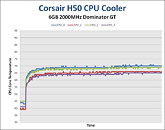Wednesday, August 12th 2009

Corsair Labs Tells Why Quality CPU Cooling is Essential for Core i7 Memory Overclock
Corsair Labs recently conducted testing to determine whether the use of high-performance DDR3 memory for Core i7 platforms also requires the use of more effective CPU cooling products.
The results clearly show that using high-performance memory results in increased CPU temperatures, due to the higher CPU VTT voltages and Uncore clock speeds required by the IMC (Integrated Memory Controller) in the Core i7 processor. The average load temperature of a Core i7-920 processor cooled by the Intel HSF (heatsink and fan) was 11 degrees C higher when utilizing 2000MHz C8 Dominator GT memory compared to 1333MHz DDR3 memory. The same PC cooled using the Corsair H50 CPU Cooler maintained average CPU core temperatures up to 24 degrees C lower than the stock Intel HSF, and was able to stably cool an overclocked CPU while also maintaining a 2000MHz DDR3 memory frequency.Standard CPU cooling solutions are inadequate for effectively cooling a Core i7-based PC using memory at frequencies above 1600MHz. Using high-performance memory running at 1866MHz or above (set by the XMP profile), the stock Intel Cooler was unable to stably cool the test PC, resulting in system crashes (BSODs) or processing errors.Enthusiasts who are looking to overclock Core i7 processors while maximising memory performance will therefore need to remove the additional heat generated due to high-performance memory and CPU overclocking by using a high-performance CPU cooling solution.
The full application note, AN901: The Impact of High-Speed DDR3 Memory on Core i7 Processor Temperatures, is available from the Corsair website here.
The results clearly show that using high-performance memory results in increased CPU temperatures, due to the higher CPU VTT voltages and Uncore clock speeds required by the IMC (Integrated Memory Controller) in the Core i7 processor. The average load temperature of a Core i7-920 processor cooled by the Intel HSF (heatsink and fan) was 11 degrees C higher when utilizing 2000MHz C8 Dominator GT memory compared to 1333MHz DDR3 memory. The same PC cooled using the Corsair H50 CPU Cooler maintained average CPU core temperatures up to 24 degrees C lower than the stock Intel HSF, and was able to stably cool an overclocked CPU while also maintaining a 2000MHz DDR3 memory frequency.Standard CPU cooling solutions are inadequate for effectively cooling a Core i7-based PC using memory at frequencies above 1600MHz. Using high-performance memory running at 1866MHz or above (set by the XMP profile), the stock Intel Cooler was unable to stably cool the test PC, resulting in system crashes (BSODs) or processing errors.Enthusiasts who are looking to overclock Core i7 processors while maximising memory performance will therefore need to remove the additional heat generated due to high-performance memory and CPU overclocking by using a high-performance CPU cooling solution.
The full application note, AN901: The Impact of High-Speed DDR3 Memory on Core i7 Processor Temperatures, is available from the Corsair website here.




20 Comments on Corsair Labs Tells Why Quality CPU Cooling is Essential for Core i7 Memory Overclock
However, I didn't know that CPU heat was so dependant on the memory used.
Of course better cooling is required for overclocking, they must be really insecure and desperate to reinvent the wheel all over again.
Exactly like the corsair h50 only NorthQ has a LED fan
www.northq.com/products/coolers/nq3580-1366.html
www.asetek.com/content/view/471/229/
Nonetheless, considering how cheap it is, I reckon they're allright.
Running high frequency memory inrease the cpu temp, and this does not happen with Core 2 duo/quad, because like we all know, the Core i7 has a memory controller (requires higher voltages for higher memory).
I most certainly do not use stock:D
www.youtube.com/watch?v=wkdOK_uHMy0